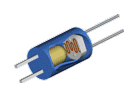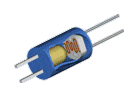Why Light Dependent Resistors?
Why did we design our Passive Preamps with light dependent resistors (LDRs)? Because they sound better than all other options. Better than any potentiometer (“pot”), better than any stepped attenuator, and better even than transformer based volume controls.
LDRs have excellent sonic quality and make it possible to have no mechanical components (relays, switches, potentiometers) in the signal path. They are the ultimate transparent volume control technology that yield complete transparency, a flat frequency response, impart no coloration, have great dynamics, and have an undeniably pleasing musical quality.
It is often said that LDR based passive preamps allow you to listen to your music, not your hardware.
What Are Light Dependent Resistors?

Light dependent resistors combine a photoresistor and a light emitting diode (LED) inside a small sealed device the size of a piece of M&M candy. The result is an optically controlled variable resistor with no moving parts. Each LDR has 2 pairs of wires. One pair is connected to the LED, the other pair is connected to the photoresistor.
Unlike a mechanical potentiometer (“pot”) or stepped attenuator, an LDR has no mechanical parts or interface point that can wear out or degrade the audio signal. Best of all, the photoresistive semiconductor material used in light dependent resistors does very little to materially degrade or color the audio signal. Photoresistors do add a slight amount of distortion to the audio signal but the level of this distortion is insignificant.
Light dependent resistors have been around for quite a while but are relatively new to audio. Using LDRs in high-end audio applications has only become practical in recent years as the technology has improved.
The photoresistor within each LDR is made of a semiconductor material that exhibit reduced resistivity when exposed to light. The resistance of an LDR is inversely proportional to the light intensity seen by the semiconductor material.
Simply put, more light = less resistance, and conversely less light = more resistance. By regulating the current flow to the LED (and thus its brightness), a pair of LDRs can be used as voltage dividers to control volume.
As an added bonus, since the control side (LED) of an LDR is optically isolated from the audio side (photoresistor), it’s possible to isolate the control circuitry from the audio signal thus allowing the LDRs to operate as true low-noise passive attenuators.
Light Dependent Resistors Are Technically Challenging
If LDRs are so good at controlling audio volume why aren’t LDRs more common in high performance audio gear? Great question!
This short answer is LDRs are challenging to use for volume control because they’re both highly nonlinear and their performance can vary considerably from one LDR to the next. This makes them very difficult to design a consistently predictable and reliable audio attenuator. These challenges can be overcome but doing so is not a trivial matter.
When we say LDRs are nonlinear what does that mean? It means the relationship between LED current/brightness and the photoresistor resistance does not remain constant as the resistance levels change. At low resistance levels, a relatively large change in LED current is required to make even a small change in photoresistor resistance level. As resistance increases you eventually begin to see significant increases in resistance with only a very small change in current. Designing with such nonlinear electronic components can be very challenging for design engineers. This is the key reason why LDRs have not been widely adopted in high performance audio applications.
It gets worse. The nonlinear behavior described above can differ significantly from one LDR to the next even within a batch of LDRs of the same make and model that were produced at the same time. Worse yet, this nonlinear relationship can change over time as the LDR ages.
Tortuga Audio has developed proprietary technology that overcomes these challenges. Tortuga Audio released it 3rd generation LDR3x.V2 preamp controller in early 2014 which completely overcomes the nonlinear and variable nature of LDRs with self-contained auto-calibration to ensure the LDRs perform optimally over their full lifetime. You can read more about this topic here.
But beyond the engineering and the technology all that really matters is this: does the music sound better with LDRs? You bet it does.


[…] 22Aug2016 – There is a recent development in audiophile volume control: Light Dependent Resistors. While it’s satisfying to see high end audio components pay closer attention to how volume control is accomplished, the cost is a bit disconcerting. I first noticed this technology implemented in the $65,000 Constellation Audio’s Reference Series Altair II / Line Stage, and for that price you don’t even get a phono stage. That said, you can’t beat the complete optical isolation this solution offers and the technology is already trickling down to more affordable preamplifiers, such as Tortuga offerings: http://51.81.208.15/saying-yes-to-light-dependent-resistors/ […]